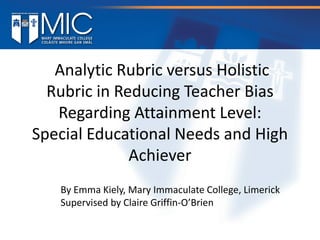1) The study sought to determine if an analytic or holistic rubric could reduce teacher bias in grading, and if student attainment level (SEN or HA) played a role.
2) Results found essays labeled as written by SEN students were graded significantly lower than HA essays without a rubric.
3) There was no main effect for rubric type, but there was a significant interaction between rubric type and attainment level, suggesting analytic rubrics may better reduce bias.


























